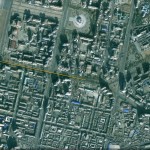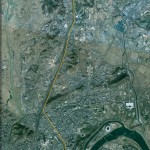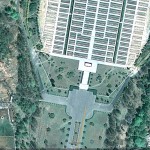UPDATE: Using North Korean television footage, I mapped out Jo Myong-rok’s funeral procession route on Google Earth.
The procession began at the Central Worker’s Hall (home of the General Federation of Trade Unions of Korea) where the VMAR’s wake was held:
The procession then traveled west to the Potong Gate (near Sojang Hall where state funerals are normally held) and then north to the Patriotic Martyr’s Cemetary.
Jo Myong-rok was bruied in the front row of the cemetary in one of the empty spots.
I wonder which two individuals will be buried next to him? Judging from the satellite imagery, it appers this cemetary is being expanded for additional martyrs. I wonder what the criteria are to be buried here.
ORIGINAL POST: According to KCNA (11/6/2010):
Vice Marshal of the Korean People’s Army Jo Myong Rok, member of the Presidium of the Political Bureau of the Central Committee of the Workers’ Party of Korea, first vice-chairman of the DPRK National Defence Commission and deputy to the Supreme People’s Assembly, died of an inveterate heart disease at 10:30 a.m. on Nov. 6, Juche 99 (2010) at the age of 82 to our sorrow.
Born into a poor peasant’s family in Yonsa County, North Hamgyong Province on July 12, Juche 17 (1928) Jo Myong Rok was a revolutionary comrade loyal to General Secretary Kim Jong Il and a prominent activist of the WPK, the state and the army of the DPRK who devoted his whole life to the sacred struggle for the freedom and independence of the country and the victory of the cause of socialism.
He grew up to be an able military and political official under the care of the party and the leader after the country’s liberation.
He worked for years at important posts of the party, the state and the army.
In the period of the hard-fought Fatherland Liberation War against the U.S. imperialists’ armed invasion he bravely fought as a pilot of the KPA for the victory in the war. He worked hard for the development of the air force, holding posts of squadron commander, group commander and divisional commander of an air unit and the chief of the staff and commander of the air force of the KPA in the post-war period.
Holding important posts as the director of the General Political Bureau of the KPA from October, Juche 84 (1995) and first vice- chairman of the DPRK National Defence Commission from September, Juche 87 (1998), he energetically worked to thoroughly implement the Juche-oriented military line of the WPK and firmly guarantee the building of a thriving nation and the victory of the revolutionary cause of Juche with matchless military power.
He was elected alternate member of the C.C., the WPK in November, Juche 64 (1975), member of the C.C., the WPK and member of the Central Military Commission of the WPK in October, Juche 69 (1980) and member of the Presidium of the Political Bureau of the C.C., the WPK in September, Juche 99 (2010) and worked as a deputy to the Supreme People’s Assembly from the sixth Supreme People’s Assembly held in November, Juche 66 (1977).
He was awarded Order of Kim Il Sung, the highest order of the DPRK, the titles of Hero of the DPRK and Labour Hero and many other orders and medals including Order of National Flag First Class and Order of Freedom and Independence First Class for the distinguished feats he performed for the party and the revolution, the country and its people.
He received the title of vice marshal of the KPA in October, Juche 84 (1995).
An obituary of Jo Myong Rok was jointly issued by the C.C., the WPK, the Central Military Commission of the WPK, the DPRK National Defence Commission and the Presidium of the DPRK Supreme People’s Assembly on Saturday.
The obituary said that his death is a great loss to the party, the army and people of the DPRK waging a dynamic struggle to win the victory of the cause of building a thriving socialist nation and bring earlier the independent reunification of the country. Though he passed away, the exploits he performed for the party and the revolution, the country and its people will shine long along with the victorious advance of the revolutionary cause of Juche, it stressed.
On the same day, the C.C., the WPK, the Central Military Commission of the WPK, the DPRK National Defence Commission and the Presidium of the DPRK Supreme People’s Assembly announced that the late Jo Myong Rok would be accorded a state funeral and formed a state funeral committee with Kim Jong Il as its chairman and Kim Jong Un and 169 others as its members.
The state funeral committee informed the public that the bier of the deceased would be placed in the Central Hall of Workers, it would receive mourners from 10:00 on Nov. 8 to 18:00 on Nov. 9 and the hearse would leave the hall at 9 a.m. on Nov. 10.
KCNA also reports (11/8/2010):
Leading officials of the state and armed forces organs Monday visited the bier of Vice Marshal of the Korean People’s Army Jo Myong Rok, member of the Presidium of the Political Bureau of the Central Committee of the Workers’ Party of Korea, first vice-chairman of the National Defense Commission of the DPRK and deputy to the Supreme People’s Assembly, to express deep condolences over his death.
Seen standing before the bier of the late Jo Myong Rok was a wreath sent by Kim Jong Il, general secretary of the Workers’ Party of Korea, chairman of the DPRK National Defence Commission and supreme commander of the Korean People’s Army.
Also seen standing before the bier were wreaths sent by the C.C., the WPK, the Central Military Commission of the WPK, the NDC of the DPRK, the Presidium of the Supreme People’s Assembly of the DPRK, the DPRK Cabinet and the Ministry of the People’s Armed Forces.
Among the mourners were Choe Yong Rim, Jon Pyong Ho, Pyon Yong Rip, Kim Rak Hui, Kim Chang Sop, Ri Ha Il, anti-Japanese veteran fighters Ri Ul Sol and Kim Chol Man, and Kim Yong Dae, chairman of the C.C., the Korean Social Democratic Party, and Ryu Mi Yong, chairperson of the C.C., the Chondoist Chongu Party.
They observed a moment’s silence in memory of the late Jo Myong Rok and expressed deep condolences to the bereaved families of the deceased.
On the same day officials of armed forces organs including the NDC and the Ministry of the People’s Armed Forces, servicepersons of KPA and the Korean People’s Internal Security Forces, officials of the party and power organs, working people’s organizations, ministries and national institutions, working people from all walks of life, the diplomatic corps and the military attaches corps here and overseas Koreans visited the Central Hall of Workers where the bier of the deceased was placed and expressed condolences over his death.
Additional Information:
1. Michael Madden has additional information on the VMAR here and here.
2. The media is highlighting that Kim Jong-un has been named after his father as a member of the state funeral committee. See here and here.
3. To see a satellite image of the Central Worker’s Hall click here. This will be the first funeral to be held in this facility since at least 1996. As far as I can tell this is the first funeral to be held there.
4. Most other state funerals are conducted in Sojang Hall in Potonggang District (Satellite image here). See a previous post I wrote about the geography of DPRK state funerals here.



